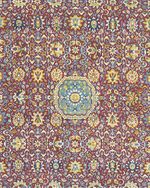Difference between revisions of "WikiRug:Featured Article/2020/40"
Jump to navigation
Jump to search
(Created page with "|right|150px India is a country located in South Asia. Indian art and culture was introduced to the world by the Mughal Em...") |
|||
| Line 1: | Line 1: | ||
[[File:Indian Carpet-WikiRug.jpg||right|150px]] | [[File:Indian Carpet-WikiRug.jpg||right|150px]] | ||
| − | [[Indian Carpet|India]] | + | The original carpet makers in [[Indian Carpet|India]] were immigrants from Persia, skilled weavers and artisans who moved there during the sixteenth century. Early Indian carpets feature a red background with traditional Persian Safavid carpets designs and weaving techniques. The carpets were produced in established workshops throughout northern and central India, most notably in the cities of Agra and Lahore.<br> |
| + | Under Shah Jahan new carpet designs and motifs were introduced, such as the Lattice, Mihrab (prayer arch), Shrub, and single tree. The Polonaise carpets style was also popular. Most often the carpets had a cotton foundation and a wool pile. The asymmetric (Persian) knot was used.('''[[Indian Carpet|Full article...]]''') | ||
Revision as of 11:01, 27 September 2020
The original carpet makers in India were immigrants from Persia, skilled weavers and artisans who moved there during the sixteenth century. Early Indian carpets feature a red background with traditional Persian Safavid carpets designs and weaving techniques. The carpets were produced in established workshops throughout northern and central India, most notably in the cities of Agra and Lahore.
Under Shah Jahan new carpet designs and motifs were introduced, such as the Lattice, Mihrab (prayer arch), Shrub, and single tree. The Polonaise carpets style was also popular. Most often the carpets had a cotton foundation and a wool pile. The asymmetric (Persian) knot was used.(Full article...)
